
Deposition Date
2008-01-21
Release Date
2008-05-20
Last Version Date
2024-03-13
Entry Detail
PDB ID:
3C0V
Keywords:
Title:
Crystal structure of cytokinin-specific binding protein in complex with cytokinin and Ta6Br12
Biological Source:
Source Organism:
Vigna radiata (Taxon ID: )
Host Organism:
Method Details:
Experimental Method:
Resolution:
1.80 Å
R-Value Free:
0.20
R-Value Work:
0.15
R-Value Observed:
0.15
Space Group:
P 64


